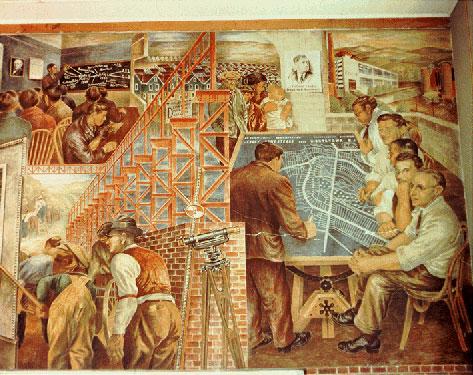
Text of interview with Bernarda Shahn conducted by Bill Fernekes and Bill Marshall at Mrs. Shahn's residence, December 15, 1998.
Shahn: After that we come into another area that Ben considered very important, and that is this wall in which there is a picture of Gompers, and that is symbolic of unionization and the importance it meant to labor, generally speaking. Then under the picture of Gompers, you see a picture of a number of people sitting in a school like a musician, and that's exactly what it is, it's the first efforts at labor education in their own economy.
Underneath that there is a scene that symbolizes the beginnings of Roosevelt and this figure in the back, that's the only figure that I painted in the mural. It's supposedly Tugwell, who really did carry this project and some fifteen or sixteen others through for resettlement.
Marshall: I just have a question for you, I heard you say before that you painted that one, did Tugwell pose for that for you?
Shahn: No, no, I did it from memory and imagination mostly.
Marshall: But he did come here, correct?
Shahn: He's been here a few times, but not with any idea that he was ever going to be painted. Tugwell was a very rather elegant, snobbish man, but he was also powerfully pro-labor.
This little corner up here is a scene of commercial types of development, which is just one house exactly like another on top of another. These houses are not exactly like it, there are seven different styles, but they are all Bauhaus.
So then, there's a picture of Roosevelt, of course, on the wall there. And down here in supposedly the back, would have been Castner the architect, and the layout of the plan of the town. And Heywood Broun is the farthest back person, Sidney Hillman, and, of course, (Sen.) Bob Wagner(D-NY), of the National Labor Relations Act, and a couple of them. Ben knew who they were, but I forgot who they were, but they were leaders in the project, which this symbolizes. Of course, this little corner here, is the ideal of countryside and orchards.
So, I think that gives the story of the mural and the one thing that I think about is what Ben wanted to do and I'm sure what Castner wanted to do, or have Ben do, was to symbolize the tremendous meaning that a community like this could have for labor, generally speaking. And labor had still not emerged to being socially equal or even economically equal in the sense of rights, so that Benputin such people as Wagner and Heywood Broun, he's one of the people in the last row, who is a great advocate of equality. I don't know that there is anything more that I can add to it.